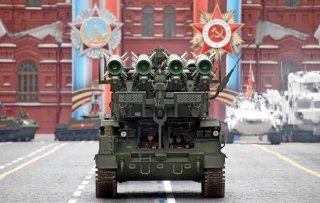2020 Was a Killer Year for Russian Military Modernization
Christmas came early for the Russian Ground Forces.
Here's What You Need to Know: No mention was made of what the individual soldiers may have received this year, but the Russian military has been adopting the Ratnik, “soldier of the future” combat outfit.
Christmas came early for the Russian Ground Forces, which received more than 2,500 new pieces of armaments this year—including advanced Buk-M3 medium-range air defense systems and Tornado-S multiple launch rocket systems (MLRS).
“In order to increase combat performance and renew the equipment in 2020, military units of Russia’s Ground Forces received over 2,500 pieces of new standard weaponry, as well as military and special hardware,” Ground Forces Commander-in-Chief Army Gen. Oleg Salyukov said in an interview with the Defense Ministry’s Krasnaya Zverda newspaper, according to a report from Tass.
The new equipment included the Buk-M3 and Tornado-S, but also the Verba fourth-generation infrared homing surface-to-air missile MANPADS (man-portable air defense systems).
The Tornado-S multiple launch rocket systems (MLRS) is reported to be the most powerful MLRS weapon in the world with the longest-range. It features improved range and accuracy over its predecessor platforms.
The advanced Tornado multiple rocket launchers are precision systems that are outfitted with smart rocket shells. These have the capability to strike an enemy’s vital facilities at considerable distances. It is a heavily upgraded version of the BM-30 Smerch multiple rocket launcher, and it features increased range and fire accuracy capabilities. It also offers the option of introducing an individual flight assignment to each of the shells, while the system was designated to strike enemy soldiers, military hardware, stationery and mobile sole/individual as well as multiple targets.
The Tornado-S is now replacing the outdated BM-27 Uragan self-propelled multiple rocket launcher system, which entered service with the Soviet Red Army in the late 1970s, along with the BM-30 Smerch heavy multiple rocket launcher of the late 1980s. Both platforms are set to be retired from service by late 2027.
“Artillery units receive Tornado-G MLRS and Msta-SM self-propelled howitzers with a new automatic fire control system,” the ground forces commander added. “Anti-tank units got the Khrizantema-SP anti-tank missile system with a unique capacity of penetrating the armor of all modern tanks in any weather conditions.”
Those who were clearly on the Ground Forces’ “nice list” were the reconnaissance teams who received Strelets combined-arms reconnaissance systems and unmanned aerial vehicles, as well as Taifun-K (Typhoon K) family of 4x4 light armored vehicles.
The Russian military’s armored units also received new platforms in 2020.
“Tank crews and motorized infantry units receive modern T-72B3M and T-80BVM tanks, BMP-3 infantry fighting vehicles, modernized BMP-2 vehicles with the Berezhok combat module and the BTR-82A wheeled armoured personnel carrier,” said Gen. Salyukov.
Notably absent from the list was the T-14 Armata tank, which had been scheduled for deployment to units this year but now will likely be arriving next year.
No mention was made of what the individual soldiers may have received this year, but the Russian military has been adopting the Ratnik, “soldier of the future” combat outfit. It utilizes lightweight body armor designed to protect up to 90 percent of a soldier's body, as well as a highly-integrated, wireless networked communication system that provides greater situational awareness and sharing of vital information and intelligence between each soldier and unit.
Now the hope is that Russia remains on the nice list, and doesn't suddenly get naughty with all of its new military hardware.
Peter Suciu is a Michigan-based writer who has contributed to more than four dozen magazines, newspapers and websites. He is the author of several books on military headgear including A Gallery of Military Headdress.
This article first appeared last year.
Image: Reuters

